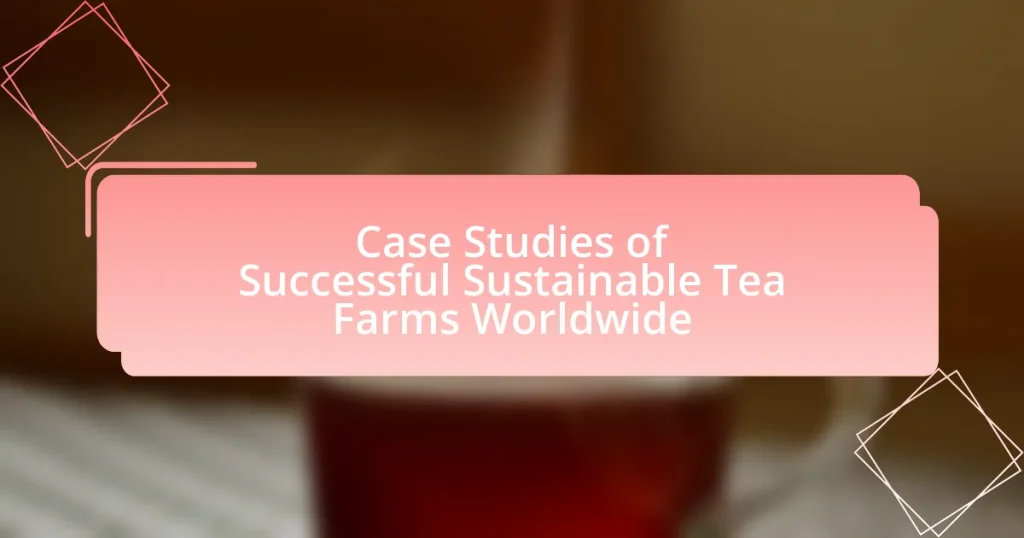Sustainable tea farms are agricultural operations that emphasize environmentally friendly practices, social responsibility, and economic viability in tea production. This article explores the principles and methods of sustainable tea farming, highlighting the differences from conventional practices, the specific techniques employed, and their positive impacts on the environment and local communities. It also examines successful case studies of sustainable tea farms worldwide, detailing the social and economic benefits, challenges faced, and the role of community involvement and technology in enhancing sustainability. Additionally, the article discusses the importance of certifications in promoting sustainable practices and provides insights into best practices for transitioning to sustainable tea farming.

What are Sustainable Tea Farms?
Sustainable tea farms are agricultural operations that prioritize environmentally friendly practices, social responsibility, and economic viability in tea production. These farms implement methods such as organic farming, agroforestry, and water conservation to minimize ecological impact while ensuring fair labor practices and supporting local communities. For instance, according to the Rainforest Alliance, sustainable tea farming can lead to a 30% increase in biodiversity and a significant reduction in pesticide use, demonstrating the effectiveness of these practices in promoting both environmental health and social equity.
How do sustainable practices differ from conventional tea farming?
Sustainable practices in tea farming prioritize environmental health, social equity, and economic viability, contrasting sharply with conventional tea farming, which often relies on synthetic fertilizers and pesticides. Sustainable tea farming employs organic methods, promotes biodiversity, and focuses on soil health, while conventional methods can lead to soil degradation and water pollution. For instance, a study by the Rainforest Alliance found that sustainable practices can reduce chemical inputs by up to 50%, enhancing ecosystem resilience and farmer livelihoods.
What specific methods are used in sustainable tea farming?
Sustainable tea farming employs specific methods such as organic farming, agroforestry, and integrated pest management. Organic farming eliminates synthetic fertilizers and pesticides, promoting soil health and biodiversity. Agroforestry involves planting tea alongside trees, which enhances ecosystem services and reduces soil erosion. Integrated pest management combines biological control, cultural practices, and resistant varieties to minimize chemical use while effectively managing pests. These methods collectively contribute to environmental sustainability and improve the livelihoods of farmers by ensuring long-term productivity and resilience.
How do these methods impact the environment?
Sustainable tea farming methods positively impact the environment by promoting biodiversity, reducing chemical usage, and enhancing soil health. These practices, such as organic farming and agroforestry, help maintain ecosystems and protect wildlife habitats. For instance, a study published in the Journal of Sustainable Agriculture found that organic tea farms support a greater variety of plant and animal species compared to conventional farms, demonstrating the benefits of reduced pesticide and herbicide application. Additionally, sustainable practices improve soil structure and fertility, which can lead to better water retention and reduced erosion, further contributing to environmental health.
Why is sustainability important in the tea industry?
Sustainability is crucial in the tea industry because it ensures the long-term viability of tea production while protecting the environment and supporting local communities. Sustainable practices, such as organic farming and fair trade, help reduce chemical usage, preserve biodiversity, and promote soil health, which are essential for maintaining high-quality tea yields. For instance, a study by the Rainforest Alliance found that sustainable tea farms can increase productivity by up to 30% while reducing environmental impact. This approach not only benefits the ecosystem but also enhances the livelihoods of farmers, creating a more equitable supply chain.
What are the social and economic benefits of sustainable tea farming?
Sustainable tea farming provides significant social and economic benefits, including improved livelihoods for farmers and enhanced environmental health. By adopting sustainable practices, tea farmers can increase their income through higher-quality yields and access to premium markets that prioritize eco-friendly products. For instance, a study by the Rainforest Alliance found that farms implementing sustainable practices saw a 20% increase in profits compared to conventional farms. Additionally, sustainable tea farming promotes community development by fostering better working conditions, fair wages, and investment in local infrastructure, which collectively contribute to poverty alleviation and social equity.
How does sustainability affect tea quality and consumer perception?
Sustainability positively affects tea quality and consumer perception by promoting environmentally friendly practices that enhance flavor and aroma while aligning with consumer values. Sustainable farming methods, such as organic cultivation and biodiversity preservation, lead to healthier soil and plants, resulting in higher-quality tea. Research indicates that consumers increasingly prefer sustainably sourced products; a 2021 survey by Nielsen found that 73% of global consumers are willing to change their consumption habits to reduce environmental impact. This shift in consumer behavior reflects a growing awareness of sustainability’s role in product quality and ethical consumption, reinforcing the market demand for sustainably produced tea.

What are some examples of successful sustainable tea farms worldwide?
Some examples of successful sustainable tea farms worldwide include the Makaibari Tea Estate in India, the Tregothnan Estate in the UK, and the Doke Tea Estate in India. Makaibari Tea Estate, located in West Bengal, is renowned for its organic practices and biodiversity conservation, producing high-quality Darjeeling tea while maintaining ecological balance. Tregothnan Estate, situated in Cornwall, focuses on sustainable farming methods and has become the first tea estate in England, emphasizing local production and environmental stewardship. Doke Tea Estate, also in India, employs organic farming techniques and promotes sustainable practices, contributing to the local economy and preserving the environment. These farms exemplify successful integration of sustainability in tea production, demonstrating that eco-friendly practices can coexist with high-quality tea cultivation.
How do these farms implement sustainable practices?
These farms implement sustainable practices by utilizing organic farming methods, promoting biodiversity, and conserving water resources. For instance, many successful sustainable tea farms avoid synthetic pesticides and fertilizers, opting instead for natural alternatives that enhance soil health and reduce environmental impact. Additionally, these farms often incorporate agroforestry techniques, which involve planting trees alongside tea crops to create a diverse ecosystem that supports wildlife and improves soil quality. Evidence of their effectiveness can be seen in the increased yield and quality of tea produced, as well as the positive impact on local biodiversity and water conservation efforts.
What innovative techniques have been adopted by these farms?
Innovative techniques adopted by successful sustainable tea farms worldwide include agroforestry, organic farming practices, and precision agriculture. Agroforestry integrates tea cultivation with tree planting, enhancing biodiversity and improving soil health. Organic farming practices eliminate synthetic pesticides and fertilizers, promoting environmental sustainability and producing healthier tea. Precision agriculture utilizes technology such as drones and soil sensors to optimize resource use and increase yield efficiency. These methods have been shown to improve both ecological balance and economic viability, as evidenced by case studies demonstrating increased crop resilience and higher market prices for sustainably produced tea.
How do these farms measure their sustainability success?
These farms measure their sustainability success through various metrics, including environmental impact assessments, resource efficiency, and social responsibility indicators. For instance, they often track reductions in water usage, improvements in soil health, and biodiversity levels to evaluate ecological sustainability. Additionally, many farms utilize certifications such as Rainforest Alliance or Fair Trade, which provide benchmarks for social and economic sustainability. Data collected from these assessments and certifications demonstrate the farms’ commitment to sustainable practices and their effectiveness in achieving long-term sustainability goals.
What challenges do these farms face in maintaining sustainability?
Sustainable tea farms face challenges such as soil degradation, water scarcity, and pest management. Soil degradation occurs due to intensive farming practices that deplete nutrients, impacting crop yields and farm viability. Water scarcity is exacerbated by climate change, leading to reduced water availability for irrigation, which is critical for tea cultivation. Additionally, pest management becomes increasingly difficult as traditional methods may harm beneficial insects and the environment, necessitating the adoption of integrated pest management strategies. These challenges highlight the need for innovative practices to ensure long-term sustainability in tea farming.
How do they overcome obstacles related to climate change?
Sustainable tea farms overcome obstacles related to climate change by implementing adaptive agricultural practices and utilizing technology. These farms often adopt agroforestry techniques, which enhance biodiversity and improve soil health, thereby increasing resilience to climate impacts. For instance, a study by the International Tea Committee highlights that integrating shade trees in tea cultivation can reduce temperature fluctuations and conserve moisture, leading to better crop yields even under changing climate conditions. Additionally, many farms invest in water management systems, such as rainwater harvesting and drip irrigation, to optimize water use and mitigate drought effects. These strategies collectively enable tea farms to maintain productivity and sustainability in the face of climate challenges.
What role does community involvement play in their success?
Community involvement is crucial for the success of sustainable tea farms as it fosters collaboration, enhances local economies, and promotes environmental stewardship. Engaging local communities allows tea farms to source labor and resources sustainably, ensuring that farming practices align with the needs and values of the community. For instance, successful tea farms often implement programs that educate farmers on sustainable practices, leading to improved crop yields and quality. Research indicates that farms with strong community ties report higher profitability and resilience against market fluctuations, as they benefit from local knowledge and support networks. This symbiotic relationship not only boosts the farms’ success but also contributes to the overall well-being of the community, creating a sustainable model for agricultural practices.

What lessons can be learned from successful sustainable tea farms?
Successful sustainable tea farms demonstrate the importance of integrating ecological practices with economic viability. These farms often implement agroecological methods, such as intercropping and organic fertilization, which enhance soil health and biodiversity. For instance, a study by the International Union for Conservation of Nature found that farms employing these practices can increase yields by up to 30% while reducing chemical inputs. Additionally, successful farms prioritize fair labor practices and community engagement, which fosters a supportive local economy and improves worker satisfaction. Evidence from the Rainforest Alliance indicates that certified farms see a 20% increase in profitability due to consumer preference for ethically sourced products. These lessons highlight the effectiveness of sustainable practices in achieving both environmental and economic goals in the tea industry.
How can other tea farms adopt similar sustainable practices?
Other tea farms can adopt similar sustainable practices by implementing integrated pest management, organic farming techniques, and water conservation methods. For instance, farms can reduce chemical pesticide use by introducing natural predators, which has been shown to decrease pest populations effectively while maintaining crop yields. Additionally, transitioning to organic fertilizers can enhance soil health and biodiversity, as evidenced by studies indicating that organic farming can increase soil organic matter by 20-30% over conventional methods. Furthermore, adopting rainwater harvesting systems can significantly reduce water usage, with some farms reporting a 50% decrease in water consumption. These practices not only promote environmental sustainability but also improve the long-term viability of tea production.
What are the key steps for transitioning to sustainable farming?
The key steps for transitioning to sustainable farming include assessing current practices, implementing soil health improvements, adopting crop rotation, integrating pest management, and engaging in community education. Assessing current practices allows farmers to identify areas for improvement, while enhancing soil health through organic amendments and cover cropping promotes biodiversity and resilience. Crop rotation helps prevent pest and disease buildup, and integrated pest management reduces reliance on chemical pesticides. Engaging in community education fosters knowledge sharing and supports local sustainable initiatives. These steps are supported by research indicating that sustainable practices can increase yields and improve environmental health, as seen in successful tea farms that have adopted these methods.
What resources are available for farmers looking to become sustainable?
Farmers looking to become sustainable can access various resources, including government programs, agricultural extension services, and non-profit organizations focused on sustainable practices. For instance, the USDA offers grants and technical assistance through its Sustainable Agriculture Research and Education (SARE) program, which supports innovative practices that enhance sustainability. Additionally, organizations like the Rainforest Alliance provide certification programs and resources that help farmers implement sustainable farming techniques, improve biodiversity, and increase market access. These resources are designed to educate farmers on best practices and provide financial support for transitioning to sustainable methods.
What best practices can be applied to enhance sustainability in tea farming?
Best practices to enhance sustainability in tea farming include implementing organic farming techniques, promoting agroforestry, and utilizing water conservation methods. Organic farming techniques reduce chemical inputs, which can lead to healthier soil and ecosystems; for instance, a study by the International Federation of Organic Agriculture Movements found that organic tea farms can increase biodiversity and improve soil health. Agroforestry, which integrates trees with tea cultivation, enhances carbon sequestration and provides habitat for wildlife, as demonstrated by successful models in India and Sri Lanka. Water conservation methods, such as rainwater harvesting and drip irrigation, help optimize water use, crucial in regions facing water scarcity. These practices collectively contribute to the long-term viability and environmental health of tea farming.
How can technology improve sustainability in tea production?
Technology can improve sustainability in tea production by enhancing resource efficiency and reducing environmental impact. Precision agriculture technologies, such as soil sensors and drones, enable farmers to monitor crop health and optimize water usage, leading to reduced water consumption by up to 30%. Additionally, data analytics can help in predicting pest outbreaks, allowing for targeted interventions that minimize pesticide use. For instance, a study by the International Tea Committee found that integrating technology in tea farming practices can increase yield while decreasing chemical inputs, thus promoting a more sustainable production model.
What role do certifications play in promoting sustainable tea farming?
Certifications play a crucial role in promoting sustainable tea farming by providing a framework for environmental and social standards that farmers must adhere to. These certifications, such as Rainforest Alliance and Fair Trade, incentivize farmers to adopt practices that reduce chemical use, conserve water, and protect biodiversity. For instance, a study by the International Institute for Environment and Development found that certified farms often achieve higher yields and better market access, leading to improved livelihoods for farmers. Additionally, certifications enhance consumer trust and awareness, driving demand for sustainably produced tea, which further encourages farmers to maintain sustainable practices.


